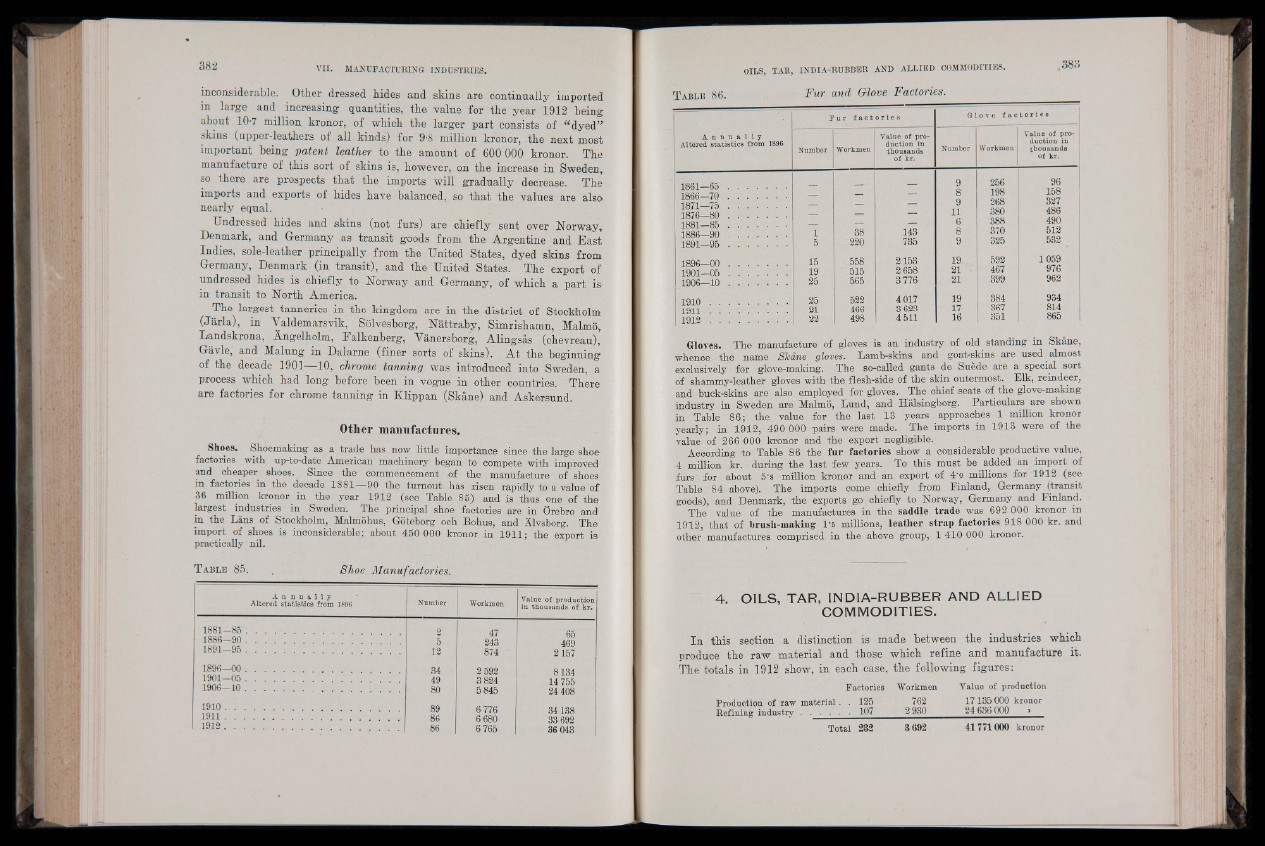
inconsiderable; Other dressed hides and skins are continually imported
in large and increasing quantities, the value for the year 1912 being
about 10-7 million kronor, of which the larger part consists of “ dyed”
skins (upper-leathers of all kinds) for 9*8 million kronor, the next most
important being patent leather to the amount of 600 000 kronor. The
manufacture of this sort of skins is, however, on the increase in Sweden,
so there are prospects that the ini ports will gradually decrease. The
imports and exports of hides have balanced, so that the values are also
nearly equal.
Undressed hides and skins (not furs) are chiefly sent over Norway,
Denmark, and Germany as transit goods from the Argentine and East
Indies, sole-leather principally from the United States, dyed skins from
Germany, Denmark (in transit), and 1he United States. The export of
undressed hides is chiefly to Norway and Germany, of which a part is
in transit to North America.
The largest tanneries in the kingdom are in the district of Stockholm
(Järla), in Yaldemarsvik, Sölvesborg, Nattraby, Simrishamn, Malmö,
Landskrona, Angelholm, Ealkenberg, Vänersborg, Alingsäs (chevreau),
Gävle, and Malung in Dalarne (finer sorts of skins). At the beginning
of the decade 1901— 10, chrome tanning was introduced into Sweden, a
process which had long before been in vogue in other countries. There
are factories for chrome tanning in Klippan (Skäne) and Askersund.
Other manufactures.
Shoes. Shoemaking as a trade has now little importance since the large shoe
factories with up-to-date American machinery began to compete with improved
and cheaper shoes. Since the commencement of the manufacture of shoes
in factories in the decade 18 8 1—90 the turnout has risen rapidly to a value o f
36 million kronor in the year 1912 (see Table 85) and is thus one of the
largest industries in Sweden. The principal shoe factories are in Örebro and
in the Läns of Stockholm, Malmöhus, Göteborg och Bohus, and Älvsborg. The
import of shoes is inconsiderable; about 450 000 kronor in 1911; the export is:
practically nil.
Table 85. j Shoe Manufactories.
A n n u a l l y
Altered statistics from 1896 Nnmber Workmen Value of production
in thousands of kr.
1881—85 ................................ g 47
1886-90 ............................................ 5 243 1891—95 .................................... 469 .12 874 j 2157
1896—00 ........................................ 34 2 592 8134 1901—05 ............................................ 49 3 824 14 755 1906—10 .................... .... . . . 80 5 845 24 408
1910............................................ 89 6 776 34138 1911........................................ 86 6 680 33 692 1912............................................ 86 6765 36 043
Table 86. , Fur and Glove Factories.
F u r f a c t o r i e s Gl o v e f a c t o r i e s
A n n u a l l y
Altered statistics from 1896
Number Workmen
Value of production
in
thousands
of kr.
Number Workmen
Value of production
in
thousands
of kr.
1861 65 ........................
1866 70 ........................
1871 75 ........................
1876 80 . . . . . . .
1881 85 ........................
1886 90 . . . . . . .
1891—95 ........................
1
5
38
220
143
735
989
11
6
8
9
256
198
268
380
388
370
325
96
158
327
486
490
512
532 _
1896—00 ........................
1901 05 . . . . .
1906 10 . . . . . . .
.-V45\L*..
19
25
558
' 515
565
2153
2 658
3776
19
21 B
21
592
467
399
1059
976
962
191 0 ...................... ...
191 1 ..........................
1912 . ....................... .
25
21
22
522
466
498
4 017
3 623
4 511
19
17
: 16
384
367
351
934
814
865
Gloves. The manufacture of gloves is an industry of old standing in Skàne,
whence the name Slcdne gloves. Lamb-skins and goat-skins are used ^ almost
exclusively for glove-making. The so-called gants de Suède are a special sort
of shammy-leather gloves with the flesh-side of the skin outermost. Elk, reindeer,
and buck-skins are also employed for gloves. The chief seats of the glove-making
industry in Sweden are Malmo, Lund, and Halsingborg. Particulars are shown
in Table 86; the value for the last 13 years approaches 1 million kronor
yearly; in 1912, 490 000 pairs were made. The imports in 1913 were of the
value o f 266 000 kronor and the export negligible.
According to Table 86 the fur factories show a considerable productive value,
4 million kr. during the last few years. To this must be added an import of
furs for about 5'8 million kronor and an export of 4*0 millions for 1912 (see
Table 84 above). The imports come chiefly from Finland, Germany (transit
goods), and Denmark, the exports go chiefly to Norway, Germany and Finland.
The value of the manufactures in the saddle trade was 692 000 kronor in
1912, that of brusli-makiug 1*6 millions, leather strap factories 918 000 kr. and
other manufactures comprised in the above group, 1 410 000 kronor.
4. OILS, TAR, INDIA-RUBBER AND ALLIED
COMMODITIES.
In this section a distinction is made between the industries which
produce the raw material and those which refine and manufacture it.
The totals in 1912 show, in each case, the following figures;
Factories Workmen Yalue of production
Production of raw material. . 125 762 17 135 000 kronor
Refining industry ................ 107 2 930 24 636 000 >
Total 232 3692 41771000 kronor